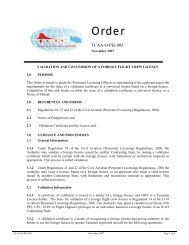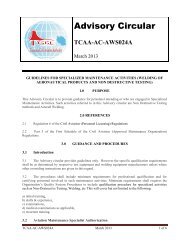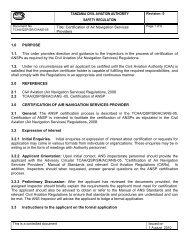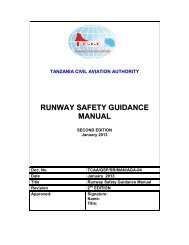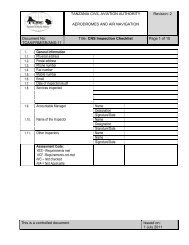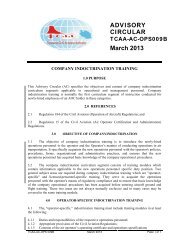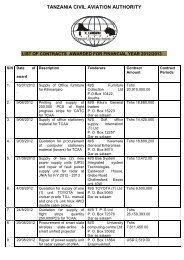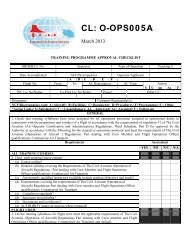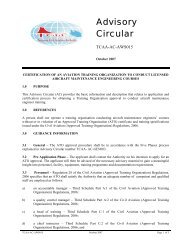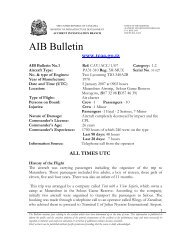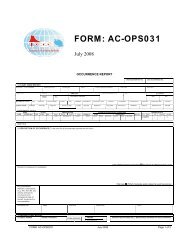Procedures for Changes to Physical Characteristics at Aerodromes
Procedures for Changes to Physical Characteristics at Aerodromes
Procedures for Changes to Physical Characteristics at Aerodromes
You also want an ePaper? Increase the reach of your titles
YUMPU automatically turns print PDFs into web optimized ePapers that Google loves.
Document No.TCAA/QSP/SR/AC/AGA-010TANZANIA CIVIL AVIATION AUTHORITYSAFETY REGULATIONAERODROMES AND AIR NAVIGATIONSERVICESPROCEDURES FOR NOTIFICATION OFCHANGES TO PHYSICALCHARACTERISTICS AT AERODROMESRevision: 0Page 1 of 201.0 PURPOSEThe purpose of this Advisory Circular is <strong>to</strong> provide guidance <strong>to</strong> aerodrome opera<strong>to</strong>rs onthe procedures <strong>for</strong> notifying the Authority on the development of aerodromes and otherassoci<strong>at</strong>ed changes <strong>to</strong> the physical characteristics of the aerodrome with a view <strong>to</strong>ensure th<strong>at</strong> the changes comply with certific<strong>at</strong>ion criteria and safe management of theresulting changes.2.0 REFERENCES2.1 Civil Avi<strong>at</strong>ion (<strong>Aerodromes</strong>) Regul<strong>at</strong>ions, 20072.2 ICAO Annex 14 – Volume 13.0 INTRODUCTION1) Projects th<strong>at</strong> involve changes <strong>to</strong> the aerodrome physical characteristics fall in<strong>to</strong> 3c<strong>at</strong>egories:a) DevelopmentWhere new or upgraded infrastructure is <strong>to</strong> be provided: Examples include new orextensions <strong>to</strong> buildings, aerodrome infrastructure (such as taxiways and aprons), visualaids and navig<strong>at</strong>ion aids.b) <strong>Changes</strong>Where existing aerodrome infrastructure or physical characteristics are being changed:<strong>for</strong> example reconfigur<strong>at</strong>ion of stands, changes <strong>to</strong> the runway or declared distances.<strong>Changes</strong> include projects th<strong>at</strong> involve removing or amending existing aerodromecertific<strong>at</strong>e/licence vari<strong>at</strong>ions.c) MaintenanceWhere existing infrastructure is being repaired, refurbished or replaced: i.e. <strong>to</strong> ensurecontinuance but without changing the characteristics of the piece of infrastructure.This is a controlled document Issued Oc<strong>to</strong>ber 2010
Document No.TCAA/QSP/SR/AC/AGA-010TANZANIA CIVIL AVIATION AUTHORITYSAFETY REGULATIONAERODROMES AND AIR NAVIGATIONSERVICESPROCEDURES FOR NOTIFICATION OFCHANGES TO PHYSICALCHARACTERISTICS AT AERODROMESRevision: 0Page 2 of 204.0 AERODROME CERTIFICATION/LICENSING4.1 1) The grant of an aerodrome certific<strong>at</strong>e/licence is governed by the Aerodromeregul<strong>at</strong>ions, which requires the TCAA <strong>to</strong> grant a certific<strong>at</strong>e/licence in respect ofany aerodrome in Tanzania if it is s<strong>at</strong>isfied th<strong>at</strong> the aerodrome is safe <strong>for</strong> use byaircraft, having regard in particular <strong>to</strong> the physical characteristics of theaerodrome and of its surroundings. When an aerodrome receives itscertific<strong>at</strong>e/licence, it is granted on the basis th<strong>at</strong> it meets aerodromecertific<strong>at</strong>ion/licensing criteria, unless vari<strong>at</strong>ions <strong>to</strong> these criteria have been agreedby the TCAA.2) An aerodrome certific<strong>at</strong>e/licence condition requires th<strong>at</strong> changes in the physicalcharacteristics of the aerodrome, including the erection of new buildings andalter<strong>at</strong>ions <strong>to</strong> existing buildings or the visual aids, shall not be made without priorapproval of the TCAA. The purpose of this is <strong>to</strong> ensure th<strong>at</strong> the TCAA iss<strong>at</strong>isfied th<strong>at</strong> changes in the physical characteristics meet licensing criteria anddo not present a safety hazard. Failure <strong>to</strong> notify the TCAA of changes may leavethe aerodrome vulnerable <strong>to</strong> costly remedial action or oper<strong>at</strong>ional restrictions.3) Project proposals should comply with the criteria contained in <strong>Aerodromes</strong>Regul<strong>at</strong>ions. Additionally, some proposals provide an opportunity <strong>to</strong> reviewexisting vari<strong>at</strong>ions <strong>to</strong> licensing criteria, with the intention of removal, wherepossible. Where a vari<strong>at</strong>ion cannot be removed, a supporting hazard analysisshould be carried out, taking in<strong>to</strong> account current and <strong>for</strong>eseeable oper<strong>at</strong>ions,and the outcome of the analysis acted upon accordingly. However, there may becircumstances where the proposal does not comply with licensing criteria, butwould enhance safety. In such cases additional safety assurance will berequired <strong>to</strong> assist the TCAA in examining its feasibility.This is a controlled document Issued Oc<strong>to</strong>ber 2010
Document No.TCAA/QSP/SR/AC/AGA-010TANZANIA CIVIL AVIATION AUTHORITYSAFETY REGULATIONAERODROMES AND AIR NAVIGATIONSERVICESPROCEDURES FOR NOTIFICATION OFCHANGES TO PHYSICALCHARACTERISTICS AT AERODROMESRevision: 0Page 3 of 204.2 Engagement with the Authority1) Whenever possible, aerodrome certific<strong>at</strong>e/licence holders should in<strong>for</strong>m the TCAAof <strong>for</strong>thcoming projects and changes in good time prior <strong>to</strong> the process described insubsequent This AC. This will enable the TCAA <strong>to</strong> identify the level of specialistresources required <strong>to</strong> meet their objectives, <strong>to</strong> plan and <strong>to</strong> manage the workinvolved. Typically, developments involving navig<strong>at</strong>ion aids, instrument flightprocedure changes, ATC facilities and aeronautical ground lighting might require alead-time of 6 months.2) Projects th<strong>at</strong> involve changes <strong>to</strong> the aerodrome’s infrastructure will require priorapproval and should be submitted <strong>to</strong> the Authority using the submission process inSection 7.3) Projects th<strong>at</strong> involve the construction of new facilities, extensions or enhancementsare classed as development, and will also require prior approval from the TCAA.4) Submissions and other communic<strong>at</strong>ions should be sent either electronically by e-mail <strong>to</strong>: or hard copy <strong>to</strong> the following address;The Direc<strong>to</strong>r GeneralTanzania Civil Avi<strong>at</strong>ion AuthorityP. O. Box 2819DAR ES SALAAM5) The TCAA will assess the proposal, identify whether the project is minor or major,using the criteria shown in Section 5 and in<strong>for</strong>m the aerodrome accordingly. Whennecessary, the TCAA will seek involvement of specialists from within or without.This is a controlled document Issued Oc<strong>to</strong>ber 2010
Document No.TCAA/QSP/SR/AC/AGA-0104.2 Development MeetingsTANZANIA CIVIL AVIATION AUTHORITYSAFETY REGULATIONAERODROMES AND AIR NAVIGATIONSERVICESPROCEDURES FOR NOTIFICATION OFCHANGES TO PHYSICALCHARACTERISTICS AT AERODROMESRevision: 0Page 4 of 201) An Initial Development Meeting (IDM) may be required <strong>to</strong> brief the TCAA on theproject when the TCAA deems it necessary. Where possible, all aspects of thedevelopment should be covered <strong>at</strong> the IDM and a present<strong>at</strong>ion, given by theaerodrome certific<strong>at</strong>e/licence holder, often proves the most successful way <strong>to</strong> briefall participants. Notes of the meeting should be produced by the aerodromecertific<strong>at</strong>e/licence holder and agreed by all parties.2) Ideally, outline plans and drawings should be made available <strong>to</strong> the TCAA be<strong>for</strong>ethe IDM, in sufficient time <strong>to</strong> ensure th<strong>at</strong> the IDM achieves the maximum benefit.Further development meetings can be expected both whilst preparing <strong>for</strong> and duringthe development. It may also be necessary <strong>for</strong> some meetings <strong>to</strong> take place <strong>at</strong> theaerodrome.3) The TCAA will deal directly with the aerodrome certific<strong>at</strong>e/licence holder or hisappointed represent<strong>at</strong>ive who will be expected <strong>to</strong> <strong>at</strong>tend each meeting, althoughconsultants may also <strong>at</strong>tend.5. Aerodrome Development Project Charges1) Aerodrome developments are classified as major or minor as described in this AC.In accordance with the TCAA AIC on avi<strong>at</strong>ion charges, when an applic<strong>at</strong>ion is made<strong>to</strong> obtain approval from the TCAA of a major development project <strong>at</strong> an aerodrome,the aerodrome shall be charged. The purpose of this is <strong>to</strong> enable the TCAA <strong>to</strong>recover those costs <strong>for</strong> projects, which are deemed <strong>to</strong> be over and above thoseincurred during normal regula<strong>to</strong>ry oversight.2) A TCAA assessment team will evalu<strong>at</strong>e each development proposal in detail andclassify it as major or minor depending on the level of regula<strong>to</strong>ry oversight expected<strong>to</strong> see the project <strong>to</strong> a s<strong>at</strong>isfac<strong>to</strong>ry conclusion. The team will ensure all developmentproposals are evalu<strong>at</strong>ed consistently, will explain the reasons <strong>for</strong> the decisionreached, and may also involve the aerodrome certific<strong>at</strong>e/licence holder in assistingThis is a controlled document Issued Oc<strong>to</strong>ber 2010
Document No.TCAA/QSP/SR/AC/AGA-010TANZANIA CIVIL AVIATION AUTHORITYSAFETY REGULATIONAERODROMES AND AIR NAVIGATIONSERVICESPROCEDURES FOR NOTIFICATION OFCHANGES TO PHYSICALCHARACTERISTICS AT AERODROMESRevision: 0Page 5 of 20with the evalu<strong>at</strong>ion process. The TCAA will in<strong>for</strong>m the aerodrome in writing of theoutcome of the evalu<strong>at</strong>ion process and the r<strong>at</strong>ionale <strong>for</strong> the decision.3) The criteria used <strong>to</strong> determine whether a development is deemed <strong>to</strong> be major orminor may include the following, although this list is not exhaustive:• The complexity of the development;• The number of site visits required;• The impact on aerodrome oper<strong>at</strong>ions (level of disruption <strong>to</strong> normaloper<strong>at</strong>ions);• <strong>Changes</strong> required <strong>to</strong> aerodrome oper<strong>at</strong>ions resulting from the new facility;• <strong>Changes</strong> required <strong>to</strong> the Aerodrome Manual;• Whether the development would cre<strong>at</strong>e a new certific<strong>at</strong>e/licence vari<strong>at</strong>ionth<strong>at</strong> would require detailed evalu<strong>at</strong>ion;• The need <strong>for</strong> a TCAA Flight Lighting Check (<strong>for</strong> AGL projects);• The level of internal TCAA liaison required – Air Traffic Services, FlightOper<strong>at</strong>ions, Airspace/Instrument Flight <strong>Procedures</strong>4) Typically, the projects listed in Table 1 below are those th<strong>at</strong> may qualify as a majordevelopment.When an applic<strong>at</strong>ion is made <strong>to</strong> obtain approval from the TCAA of a major developmentproject <strong>at</strong> an aerodrome, the applicant shall pay a charge as may be approved. Where thetime taken <strong>to</strong> process the applic<strong>at</strong>ion <strong>for</strong> approval exceeds 6 hours then the applicant shallbe invoiced monthly in arrears on the basis of an hourly r<strong>at</strong>e of £167 <strong>for</strong> each hour inexcess of 6 hours prior <strong>to</strong> the approval being granted.This is a controlled document Issued Oc<strong>to</strong>ber 2010
Document No.TCAA/QSP/SR/AC/AGA-010TANZANIA CIVIL AVIATION AUTHORITYSAFETY REGULATIONAERODROMES AND AIR NAVIGATIONSERVICESPROCEDURES FOR NOTIFICATION OFCHANGES TO PHYSICALCHARACTERISTICS AT AERODROMESRevision: 0Page 6 of 20This is a controlled document Issued Oc<strong>to</strong>ber 2010
Document No.TCAA/QSP/SR/AC/AGA-010TANZANIA CIVIL AVIATION AUTHORITYSAFETY REGULATIONAERODROMES AND AIR NAVIGATIONSERVICESPROCEDURES FOR NOTIFICATION OFCHANGES TO PHYSICALCHARACTERISTICS AT AERODROMESRevision: 0Page 7 of 206. Project Planning and Prepar<strong>at</strong>ion1) Projects require extensive planning, and the following areas will need <strong>to</strong> beconsidered. However, it is stressed th<strong>at</strong> this list is neither manda<strong>to</strong>ry nor exhaustiveand it is recognised th<strong>at</strong> these elements may not be available or fully developed <strong>at</strong>the planning stage:• Aeronautical Ground Lighting;• Aerodrome Manual changes;• Air traffic procedures during and post-development;• ATC line of sight requirements;• Bird Hazard implic<strong>at</strong>ions;• Building Induced Turbulence;• <strong>Changes</strong> <strong>to</strong> the existing aerodrome oper<strong>at</strong>ing procedures;• <strong>Changes</strong> <strong>to</strong> Magnetic Field Density as a result of development;• Emergency <strong>Procedures</strong>;• Environmental impact;• Instrument Approach and Departure <strong>Procedures</strong> and Minima;• Project Safety Management <strong>Procedures</strong> (outline);• Proposed timescale;• Revised Low Visibility <strong>Procedures</strong>• Removal of certific<strong>at</strong>e/licence vari<strong>at</strong>ions;• Revised runway incursion prevention measures;• Signage;• Site access plan.2) Whenever a project is proposed, it is essential <strong>to</strong> establish whether it will result in achange <strong>to</strong> the established oper<strong>at</strong>ing procedures <strong>at</strong> the aerodrome. It is there<strong>for</strong>eimper<strong>at</strong>ive th<strong>at</strong> the management of any change is fully integr<strong>at</strong>ed in<strong>to</strong> theaerodrome’s safety management system and th<strong>at</strong> the aerodrome opera<strong>to</strong>r’s safetydocument<strong>at</strong>ion covers this aspect.This is a controlled document Issued Oc<strong>to</strong>ber 2010
Document No.TCAA/QSP/SR/AC/AGA-010TANZANIA CIVIL AVIATION AUTHORITYSAFETY REGULATIONAERODROMES AND AIR NAVIGATIONSERVICESPROCEDURES FOR NOTIFICATION OFCHANGES TO PHYSICALCHARACTERISTICS AT AERODROMESRevision: 0Page 8 of 203) When considering a project it is important th<strong>at</strong>, <strong>at</strong> an early stage, aerodromecertific<strong>at</strong>e/licence holders undertake a hazard appraisal and risk assessment <strong>to</strong>identify the potential hazards and associ<strong>at</strong>ed risks surrounding any proposedchanges. The ICAO Safety Management Manual (Doc 9859) provides guidance onhazard and risk assessment.4) The level of detail required should be commensur<strong>at</strong>e <strong>to</strong> the size and complexity ofthe project and the aerodrome, as well as <strong>to</strong> the safety hazard and changepresented.7. Project Submission Process7.1 Introduction1) For development projects and changes a 3-stage process will apply <strong>to</strong> assistaerodromes and ensure th<strong>at</strong> aerodrome certific<strong>at</strong>e/licence holders meet theiroblig<strong>at</strong>ions under the licensing process. This Section details the in<strong>for</strong>m<strong>at</strong>ionrequired <strong>for</strong> each of the 3 stages and the process <strong>to</strong> be followed.2) This process must be used <strong>for</strong> development projects and changes, but may also beused <strong>for</strong> significant maintenance projects should the aerodrome certific<strong>at</strong>e/licenceholder or the TCAA deem it necessary. Additionally, the process and/or elements ofit can be used wh<strong>at</strong>ever the project type or size as determined within the aerodromeSMS. The document<strong>at</strong>ion submitted may be proportion<strong>at</strong>e <strong>to</strong> the size of the project.For smaller projects it is acceptable <strong>to</strong> submit Parts 1 and 2 <strong>to</strong>gether.3) The three stage process consists of 3 separ<strong>at</strong>e parts as follows:a. Part 1: Complianceb. Part 2: Controlc. Part 3: CompletionThis is a controlled document Issued Oc<strong>to</strong>ber 2010
Document No.TCAA/QSP/SR/AC/AGA-010a. Compliance (Part 1)TANZANIA CIVIL AVIATION AUTHORITYSAFETY REGULATIONAERODROMES AND AIR NAVIGATIONSERVICESPROCEDURES FOR NOTIFICATION OFCHANGES TO PHYSICALCHARACTERISTICS AT AERODROMESRevision: 0Page 9 of 20i). Each development proposal should be accompanied by document<strong>at</strong>ion th<strong>at</strong> providesclear evidence th<strong>at</strong> the proposal con<strong>for</strong>ms <strong>to</strong> certific<strong>at</strong>ion/licensing requirementsdetailed in <strong>Aerodromes</strong> Regul<strong>at</strong>ions and other applicable TCAA circulars/orders. Itwill enable the TCAA <strong>to</strong> assess the proposal as described in Chapter 3 Part 1 andshould include:• Project Overview.• Notific<strong>at</strong>ion Form.• Compliance M<strong>at</strong>rix (<strong>to</strong> demonstr<strong>at</strong>e th<strong>at</strong> the project design meetslicensing requirements).• Scaled Drawings.An example Notific<strong>at</strong>ion Form is <strong>at</strong>tached <strong>at</strong> Appendix 2 and Compliance M<strong>at</strong>rix <strong>at</strong>Appendix 3.ii) When Part 1 has been completed <strong>to</strong> the s<strong>at</strong>isfaction of the TCAA, confirm<strong>at</strong>ion th<strong>at</strong>the project is compliant with certific<strong>at</strong>ion/licensing requirements will be given.However, if any changes are proposed <strong>to</strong> the design or build, the modifiedin<strong>for</strong>m<strong>at</strong>ion shall be notified <strong>to</strong> TCAA.b. Control (Part 2)i) Following completion and acceptance of development design, the aerodromecertific<strong>at</strong>e/licence holder must demonstr<strong>at</strong>e <strong>to</strong> the TCAA th<strong>at</strong> the project will bemanaged safely. Accordingly, the TCAA will expect aerodrome certific<strong>at</strong>e/licenceholders <strong>to</strong> develop safety assurance document<strong>at</strong>ion th<strong>at</strong> describes how theaerodrome will manage the construction works, and oper<strong>at</strong>ing procedures, <strong>to</strong>ensure th<strong>at</strong> aerodrome oper<strong>at</strong>ions can continue safely during the project.Aerodrome certific<strong>at</strong>e/licence holders should develop and implement a <strong>for</strong>malsystem <strong>for</strong> the strict control, safety management, and safeguarding and safetycoordin<strong>at</strong>ion of all airside works. Safety Assurance Document<strong>at</strong>ion can take many<strong>for</strong>ms but should be proportion<strong>at</strong>e <strong>to</strong> the size of the project.This is a controlled document Issued Oc<strong>to</strong>ber 2010
Document No.TCAA/QSP/SR/AC/AGA-010TANZANIA CIVIL AVIATION AUTHORITYSAFETY REGULATIONAERODROMES AND AIR NAVIGATIONSERVICESPROCEDURES FOR NOTIFICATION OFCHANGES TO PHYSICALCHARACTERISTICS AT AERODROMESRevision: 0Page 10 of 20ii) The aerodrome certific<strong>at</strong>e/licence holder must ensure th<strong>at</strong> systems <strong>for</strong> control andsafe management extend <strong>to</strong> contrac<strong>to</strong>rs working <strong>at</strong> the aerodrome.iii) All members of the project management team should have clearly definedresponsibilities and accountabilities in the project programme. During constructionon an aerodrome, safety levels and standards of conduct must be maintained.These are essential <strong>to</strong> promoting safety, preventing accidents and meeting theaerodrome certific<strong>at</strong>e/licence requirements.iv) It is important th<strong>at</strong> accur<strong>at</strong>e, up <strong>to</strong> d<strong>at</strong>e in<strong>for</strong>m<strong>at</strong>ion is made available <strong>to</strong> allstakeholders involved in the project, including the TCAA, both as part of the projectplanning and during the work itself. There<strong>for</strong>e, the safety assurance and projectmanagement document<strong>at</strong>ion may include any or all of the following in<strong>for</strong>m<strong>at</strong>ion:• A clear st<strong>at</strong>ement of the supervision structure <strong>for</strong> the safety management andmoni<strong>to</strong>ring of works, including contact details of key duty personnelconcerned, <strong>for</strong> both project and aerodrome management. This should includeclear responsibilities, including the person with overall accountability <strong>for</strong> thedevelopment;• Airfield Oper<strong>at</strong>ing <strong>Procedures</strong> during the development, includingcontingencies such as low visibility procedures;• Arrangements <strong>for</strong> liaison meetings/briefings between the aerodromemanagement and the contrac<strong>to</strong>rs;• Appropri<strong>at</strong>e plans and diagrams rel<strong>at</strong>ing <strong>to</strong> the contraction process;• Control of contrac<strong>to</strong>rs;• Day and night start, control and completion of work procedures;• Communic<strong>at</strong>ions procedures between the aerodrome oper<strong>at</strong>ing units (e.g.ATC, Airfield Oper<strong>at</strong>ions) and construction teams;• Emergency procedures;• Method of working;• Plans of site and diagrams of works;This is a controlled document Issued Oc<strong>to</strong>ber 2010
Document No.TCAA/QSP/SR/AC/AGA-010TANZANIA CIVIL AVIATION AUTHORITYSAFETY REGULATIONAERODROMES AND AIR NAVIGATIONSERVICESPROCEDURES FOR NOTIFICATION OFCHANGES TO PHYSICALCHARACTERISTICS AT AERODROMESRevision: 0Page 11 of 20• Points of contact - aerodrome management and contrac<strong>to</strong>r, includingidentific<strong>at</strong>ion of manager with overall responsibility;• Site access plan;• Site safeguarding and marking;• We<strong>at</strong>her minima th<strong>at</strong> will affect the works;• The general layout of the aerodrome including airside access points;• The loc<strong>at</strong>ion and limits of works areas;• The specific security access points <strong>to</strong> be used and the loc<strong>at</strong>ion and markingof the access routes <strong>to</strong> be used <strong>to</strong> reach airside sites;• Methods of control and access <strong>for</strong> works sites within the Apron andManoeuvring Area including arrangements <strong>for</strong> crossing taxiways andrunways (if applicable);• The methods and equipment <strong>to</strong> be used <strong>for</strong> protecting, marking and lightingthe boundaries of works sites and <strong>for</strong> protecting normal aerodromeoper<strong>at</strong>ions in the vicinity of the site. Also the requirement <strong>to</strong> control sitelighting <strong>to</strong> prevent distraction of aircraft crews, drivers and ATC;• The strict timing <strong>for</strong> the setting up of work sites, the start of work, dailypermitted working hours <strong>at</strong> the site and procedures <strong>to</strong> be followed <strong>for</strong> startingand s<strong>to</strong>pping work;• Aerodrome emergency procedures, including response times during periodsof WIP, should not be compromised. This extends <strong>to</strong> ensuring compensa<strong>to</strong>ryarrangements are in place <strong>to</strong> cover depletions of fire main or fire hydrantswhen the fire main has been deactiv<strong>at</strong>ed due <strong>to</strong> work in progress;• Vehicle and equipment requirements, oper<strong>at</strong>ing rules and the requirements<strong>for</strong> staff discipline;• Calcul<strong>at</strong>ing and communic<strong>at</strong>ing amended runway declared distances;• Maintaining appropri<strong>at</strong>e pavement friction characteristics;• In<strong>for</strong>m<strong>at</strong>ion on special safety requirements <strong>for</strong> aircraft oper<strong>at</strong>ions in thevicinity of works and the methods of control available on the ManoeuvringArea, including radio telecommunic<strong>at</strong>ion procedures if appropri<strong>at</strong>e;• Arrangements <strong>for</strong> the special control of ‘hot works’;• Requirements <strong>for</strong> the oper<strong>at</strong>ion of cranes and other tall structures;This is a controlled document Issued Oc<strong>to</strong>ber 2010
Document No.TCAA/QSP/SR/AC/AGA-010TANZANIA CIVIL AVIATION AUTHORITYSAFETY REGULATIONAERODROMES AND AIR NAVIGATIONSERVICESPROCEDURES FOR NOTIFICATION OFCHANGES TO PHYSICALCHARACTERISTICS AT AERODROMESRevision: 0Page 12 of 20• Arrangements <strong>for</strong> the receipt and movement of heavy or bulky loads;• Requirements <strong>for</strong> vehicle and area cleanliness, also the implic<strong>at</strong>ions ofForeign Object Debris (FOD) and loose m<strong>at</strong>erial hazards <strong>for</strong> aircraf<strong>to</strong>per<strong>at</strong>ions;• Arrangements <strong>for</strong> the disposal of waste;• In<strong>for</strong>m<strong>at</strong>ion on the safety implic<strong>at</strong>ions <strong>for</strong> the site and staff of special aircrafthazards including blast, vibr<strong>at</strong>ion, fumes and noise;• In<strong>for</strong>m<strong>at</strong>ion on the effects of strong winds <strong>at</strong> the aerodrome;• Site safety, including personnel protection.v) Guidance on Safety <strong>at</strong> <strong>Aerodromes</strong> during Construction Works is given inAdvisory Circular No TCAA-AC-AGA008.vi) Aerodrome certific<strong>at</strong>e/licence holders should ensure th<strong>at</strong> all stakeholders arenotified of aerodrome projects in a timely manner. These communic<strong>at</strong>ions shouldcontinue through the project and may include Safety Instructions, AerodromeIn<strong>for</strong>m<strong>at</strong>ion Circulars, NOTAMs or other local procedures.vii) Be<strong>for</strong>e contrac<strong>to</strong>rs start work <strong>at</strong> any aerodrome/airside loc<strong>at</strong>ion, aerodromecertific<strong>at</strong>e/licence holders should provide a comprehensive safety briefing includingthe results of ongoing hazard analyses, <strong>to</strong> ensure all in<strong>for</strong>m<strong>at</strong>ion needed <strong>to</strong> achievethe safe completion of any works or activity is clearly unders<strong>to</strong>od and agreed.Additionally, aerodrome certific<strong>at</strong>e/licence holders should hold regular progressmeetings <strong>to</strong> ensure project safety and oper<strong>at</strong>ional objectives continue <strong>to</strong> be met.There should be close moni<strong>to</strong>ring of the safety of aerodrome/airside oper<strong>at</strong>ionswhile the project work is in progress and, when reaching decisions, project prioritiesshould be subordin<strong>at</strong>e <strong>to</strong> the maintenance of safety standards.viii) When the TCAA has been assured th<strong>at</strong> the aerodrome can continue <strong>to</strong>oper<strong>at</strong>e safely during the project, approval will be given <strong>to</strong> commence work.This is a controlled document Issued Oc<strong>to</strong>ber 2010
Document No.TCAA/QSP/SR/AC/AGA-010c. Completion (Part 3)TANZANIA CIVIL AVIATION AUTHORITYSAFETY REGULATIONAERODROMES AND AIR NAVIGATIONSERVICESPROCEDURES FOR NOTIFICATION OFCHANGES TO PHYSICALCHARACTERISTICS AT AERODROMESRevision: 0Page 13 of 20i) Transition in<strong>to</strong> service is a critical phase of the project and can present complexchallenges. Careful planning and robust procedures need <strong>to</strong> be established <strong>to</strong> ensureth<strong>at</strong> the change is introduced safely and efficiently. This may be demonstr<strong>at</strong>ed byundertaking a process of oper<strong>at</strong>ional readiness, which may include simul<strong>at</strong>ions, testing,audits or sample inspections, involving appropri<strong>at</strong>e key stakeholders.ii) On completion of the development, but prior <strong>to</strong> oper<strong>at</strong>ional use, the aerodromecertific<strong>at</strong>e/licence holder should confirm <strong>to</strong> the TCAA th<strong>at</strong> the project meets the agreeddesign criteria and is fit <strong>for</strong> purpose. The TCAA will confirm th<strong>at</strong> the new facility isaccepted and may be brought in<strong>to</strong> oper<strong>at</strong>ion.iii) Safety per<strong>for</strong>mance moni<strong>to</strong>ring should be a key process of an aerodrome’s SMS, <strong>to</strong>ensure th<strong>at</strong> the introduction of the new facility continues <strong>to</strong> maintain safety standards <strong>at</strong>the aerodrome.8. Maintenance Projects1) Maintenance projects can vary enormously in size. Much maintenance workinvolves short-term minor works, such as painting, planned periodic replacements(e.g. light cleaning in accordance with a prevent<strong>at</strong>ive maintenance schedule),refinements <strong>to</strong> systems/infrastructure and small repairs <strong>to</strong> aerodrome infrastructure,which can be completed in short timescales and with limited disruption. Smallerplanned or routine maintenance works need not be notified <strong>to</strong> the TCAA, althoughthe Aerodrome Inspec<strong>to</strong>r would expect <strong>to</strong> be kept in<strong>for</strong>med of some of theseactivities.2) However, maintenance may also involve large, longer-term projects(weeks/months), which may involve many key stakeholders, and which may havesignificant impacts on oper<strong>at</strong>ions and so test the aerodrome’s safety managementsystem. Examples of major maintenance would include runway rehabilit<strong>at</strong>ion andreplacement of aerodrome ground lighting systems. Major maintenance projectsThis is a controlled document Issued Oc<strong>to</strong>ber 2010
Document No.TCAA/QSP/SR/AC/AGA-010TANZANIA CIVIL AVIATION AUTHORITYSAFETY REGULATIONAERODROMES AND AIR NAVIGATIONSERVICESPROCEDURES FOR NOTIFICATION OFCHANGES TO PHYSICALCHARACTERISTICS AT AERODROMESRevision: 0Page 14 of 20such as these should be notified directly <strong>to</strong> the Aerodrome Inspec<strong>to</strong>r, who willadvise on the approval required and maintain regula<strong>to</strong>ry oversight of the project.3) In certain circumstances, however, the Inspec<strong>to</strong>r might conclude th<strong>at</strong> the projectqualifies <strong>for</strong> the submission process described in this document. In such cases theguidance in preceding chapters should be followed.__________________________Tanzania Civil Avi<strong>at</strong>ion AuthorityThis is a controlled document Issued Oc<strong>to</strong>ber 2010
Document No.TCAA/QSP/SR/AC/AGA-010TANZANIA CIVIL AVIATION AUTHORITYSAFETY REGULATIONAERODROMES AND AIR NAVIGATIONSERVICESPROCEDURES FOR NOTIFICATION OFCHANGES TO PHYSICALCHARACTERISTICS AT AERODROMESRevision: 0Page 15 of 20APPENDIX 1 : SUBMISSION PROCEDURE FLOWCHARTThis is a controlled document Issued Oc<strong>to</strong>ber 2010
Document No.TCAA/QSP/SR/AC/AGA-010TANZANIA CIVIL AVIATION AUTHORITYSAFETY REGULATIONAERODROMES AND AIR NAVIGATIONSERVICESPROCEDURES FOR NOTIFICATION OFCHANGES TO PHYSICALCHARACTERISTICS AT AERODROMESRevision: 0Page 16 of 20APPENDIX 2NOTIFICATION OF CHANGES TO THE PHYSICAL CHARACTERISTICSThis <strong>for</strong>m shall be signed and submitted as instructed.IMPORTANT – PLEASE READ THE FOLLOWING CAREFULLY BEFORE COMPLETINGTHE FORMDear ApplicantAn aerodrome certific<strong>at</strong>e/licence condition st<strong>at</strong>es th<strong>at</strong> any change in the physicalcharacteristics of an aerodrome, including the erection of new buildings and alter<strong>at</strong>ions <strong>to</strong>existing buildings or <strong>to</strong> visual aids, shall not be made without prior approval of the TCAA.In order <strong>to</strong> consider your proposal fully, please complete this questionnaire and return <strong>to</strong> theTCAA.If you have difficulty completing the <strong>for</strong>m, please do not hesit<strong>at</strong>e <strong>to</strong> contact us <strong>at</strong>tcaa@tcaa.go.tzYours sincerelyTCAAAPPENDIX 2 (QUESTIONNAIRE)NOTIFICATION OF CHANGES TO THE PHYSICAL CHARACTERISTICS1. AERODROME DETAILSAerodrome Name: ……………..……………………………………………………………………………………This is a controlled document Issued Oc<strong>to</strong>ber 2010
Document No.TCAA/QSP/SR/AC/AGA-010TANZANIA CIVIL AVIATION AUTHORITYSAFETY REGULATIONAERODROMES AND AIR NAVIGATIONSERVICESPROCEDURES FOR NOTIFICATION OFCHANGES TO PHYSICALCHARACTERISTICS AT AERODROMESRevision: 0Page 17 of 20Aerodrome Address: ..…………………………………………………………………………………………….........................................................................…………………………Accountable Manager:Name:……………………………………………………………………………………..Tel:…………………………………………………………………………………………Email: …………………………………………………………………………………….Project Manager:Name:…………………………………………………………………………………….......................Tel:………………………………………………………………………………………........................Email: ……………………………………………………………………………………......................2. PROJECT DETAILSTitle of Project:…………………………………………………………………………………………………….Reason <strong>for</strong> Change:………………………………………………………………………………………………………............Brief Description: …………………………………………………………………………………………………….......……………………………………………………………………………………………………………………………………………………………………………………………………………………………………This is a controlled document Issued Oc<strong>to</strong>ber 2010
Document No.TCAA/QSP/SR/AC/AGA-010TANZANIA CIVIL AVIATION AUTHORITYSAFETY REGULATIONAERODROMES AND AIR NAVIGATIONSERVICESPROCEDURES FOR NOTIFICATION OFCHANGES TO PHYSICALCHARACTERISTICS AT AERODROMESRevision: 0Page 18 of 20…………………………………………………………………………………………………………………Planned Commencement D<strong>at</strong>e:……………………………………………………………………………………….........................................Planned Dur<strong>at</strong>ion of Work:..………………………………………….…………………………………………………. ............................Estim<strong>at</strong>ed Completion D<strong>at</strong>e:……………………………………………………………………………………………................................Aerodrome closed during Work in Progress? YES / NO (Delete as applicable)Hours of Work:………………………………………………………………………………………………………… ............3. SUPPORTING DOCUMENTS ATTACHEDList of Enclosed Documents:………………………………………………………………………………………………………………….………………………………………………………………………………………………………………….…………………………………………………………………………………………………………………....................................................................................................................................................................4. IMPACT ON OBSTACLE LIMITATION SURFACES (OLS)WGS 84 coordin<strong>at</strong>es in degrees, minutes, seconds of Structure:……………………………………………………………..................................................................................Ground height <strong>at</strong> site loc<strong>at</strong>ion:…………………………………………………………………………………………….................................Maximum height of Structure:…………………………………………………………………………………………….................................This is a controlled document Issued Oc<strong>to</strong>ber 2010
Document No.TCAA/QSP/SR/AC/AGA-010TANZANIA CIVIL AVIATION AUTHORITYSAFETY REGULATIONAERODROMES AND AIR NAVIGATIONSERVICESPROCEDURES FOR NOTIFICATION OFCHANGES TO PHYSICALCHARACTERISTICS AT AERODROMESRevision: 0Page 19 of 20Height of relevant OLS <strong>at</strong> Site Loc<strong>at</strong>ion:………………………………………………………………………………....................................................5. STRIP CLEARANCESStructure(s) outside Runway & Taxiway Strip: YES / NO(Delete as applicable)Structure(s) outside Runway Cleared & Graded Area: YES / NO(Delete as applicable)If ‘No’, please provide details below:…………………………………………………………...................................…………………………..........………………………………………………………………………………………………………………….………………………………………………………………………………………………………………….…………………………………………………………………………………………………………………6. FOR RUNWAY EXTENSIONS, DETAILS OF DECLARED DISTANCES6.1 TODA: TORA: LDA: ASDA:7. RUNWAY STATUS7.1 Existing: Non-Instrument/Instrument* (Delete as applicable)Proposed: Non-Instrument/Instrument* (Delete as applicable)(* For example, ILS / MLS)This is a controlled document Issued Oc<strong>to</strong>ber 2010
Document No.TCAA/QSP/SR/AC/AGA-010TANZANIA CIVIL AVIATION AUTHORITYSAFETY REGULATIONAERODROMES AND AIR NAVIGATIONSERVICESPROCEDURES FOR NOTIFICATION OFCHANGES TO PHYSICALCHARACTERISTICS AT AERODROMESRevision: 0Page 20 of 20APPENDIX 3AERODROME COMPLIANCE MATRIXAERODROME COMPLIANCE MATRIXNAME OF AERODROME.................................................PROPOSED START DATE...............................PROPOSED CHANGE.................................................................PROPOSED COMPLETION DATE........................This is a controlled document Issued Oc<strong>to</strong>ber 2010



